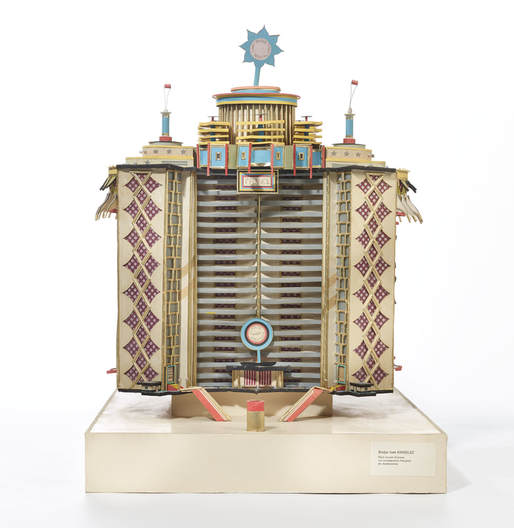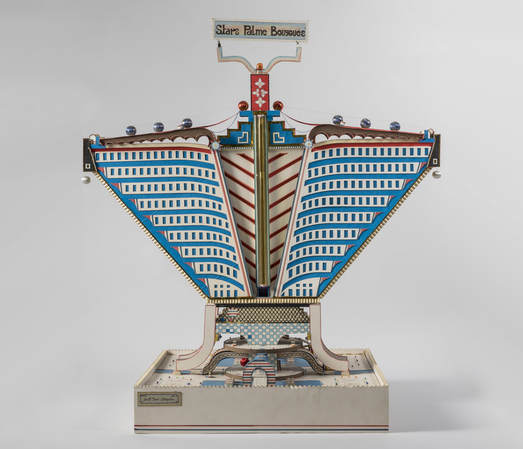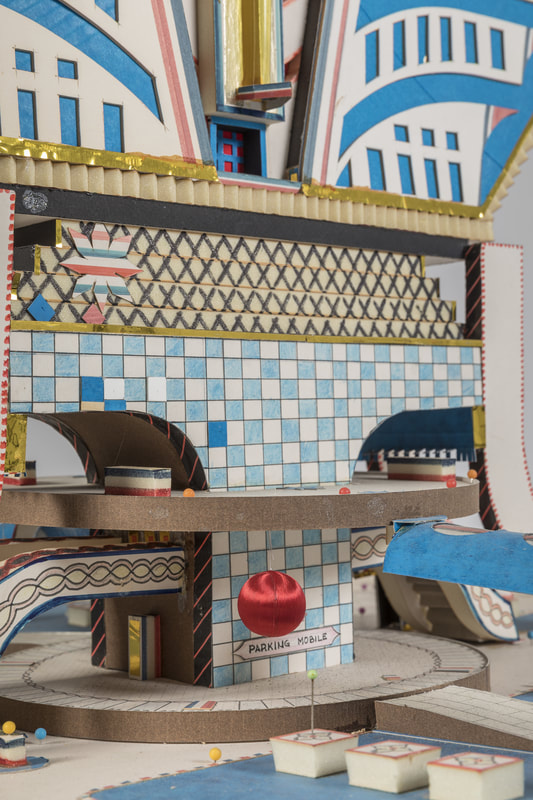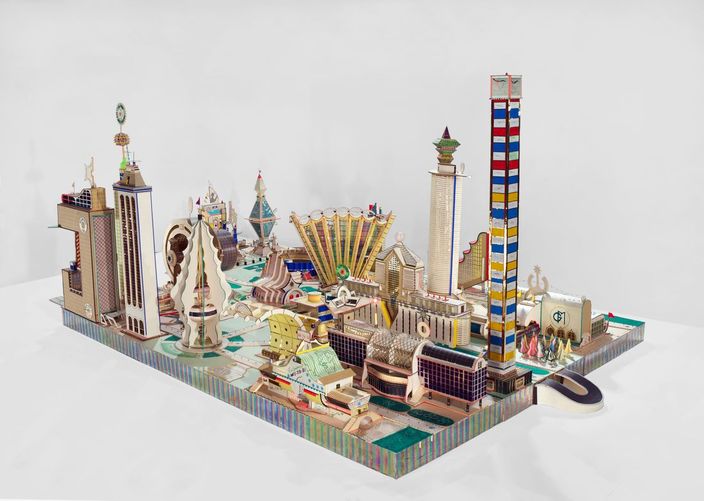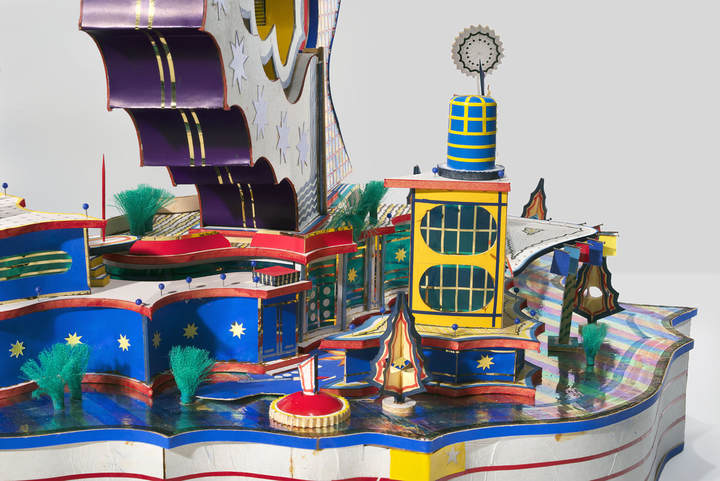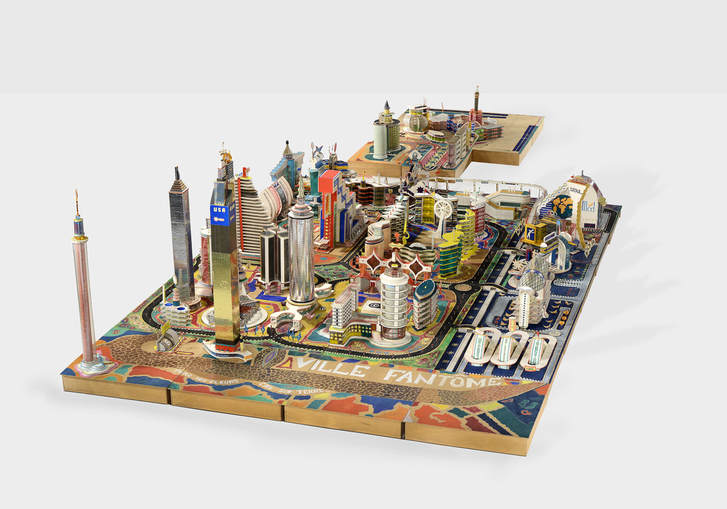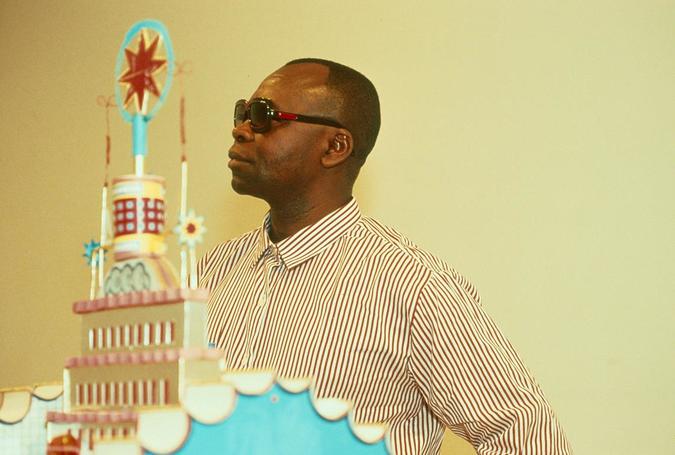The Museum Of Modern Art
Presents
Bodys Isek Kingelez: City Dreams
May 26, 2018–January 01, 2019
Bodys Isek Kingelez (Congolese, 1948-2015). Untitled. c. 1980. Paper, paperboard, and other various materials,
32 15/16 × 14 7/8 × 9 5/8″ (83.6 × 37.8 × 24.5 cm). Private collection, Paris. Photograph by Kleinefenn
32 15/16 × 14 7/8 × 9 5/8″ (83.6 × 37.8 × 24.5 cm). Private collection, Paris. Photograph by Kleinefenn
Without a model, you are nowhere. A nation that can’t make models is a nation that doesn’t understand things, a nation that doesn’t live,” said visionary artist Bodys Isek Kingelez (1948–2015). Based in then-Zaire (now the Democratic Republic of Congo), following its independence from Belgium, Kingelez made sculptures of imagined buildings and cities that reflected dreams for his country, his continent, and the world. Kingelez’s “extreme maquettes” offer fantastic, utopian models for a more harmonious society of the future.
An optimistic alternative to his own experience of urban life in his home city of Kinshasa, which grew exponentially and organically with urban planning and infrastructure often unable to keep step, his work explores urgent questions around urban growth, economic inequity, how communities and societies function, and the rehabilitative power of architecture—issues that resonate profoundly today.
Kingelez’s vibrant, ambitious sculptures are created from an incredible range of everyday materials and found objects—colored paper, commercial packaging, plastic, soda cans, and bottle caps—all meticulously repurposed and arranged. While he didn’t travel outside of Zaire until 1989, he was highly attuned to world events and deeply concerned with social issues. The Scientific Center of Hospitalisation the SIDA (1991), for example, references the AIDS crisis; Palais d’Hirochima(1991) addresses the condtion of postwar Japan; and U.N. (1995) attests to the organization’s global peacekeeping efforts and the artist’s own sense of civic responsibility.
In the complex multi-building cityscape Kimbembele Ihunga (1994), the artist reimagines his agricultural home village complete with a soccer stadium, banks, restaurants, and skyscrapers. In Ville Fantôme (1996), which will be accompanied by a Virtual Reality experience for visitors, the artist has imagined a peaceful city in which doctors and police are not needed.
The first US retrospective of Kingelez’s work, the exhibition spans his full career, from early single-building sculptures, to spectacular sprawling cities, to futuristic late works, which incorporate increasingly unorthodox materials. These rarely shown works are a call for us all to imagine, in the artist’s words, a “better, more peaceful world.”
Organized by Sarah Suzuki, Curator, with Hillary Reder, Curatorial Assistant, Department of Drawings and Prints, The Museum of Modern Art.
Exhibition design is produced in collaboration with the artist Carsten Höller.
Special thanks to Jean Pigozzi and CAAC—The Pigozzi Collection.
The exhibition is made possible by Allianz, a partner of contemporary art at MoMA.
Major support is provided by
The International Council of The Museum of Modern Art and by The Contemporary Arts Council of The Museum of Modern Art.
Generous funding is provided by The Friends of Education of The Museum of Modern Art.
Additional support is provided by the Annual Exhibition Fund.
An optimistic alternative to his own experience of urban life in his home city of Kinshasa, which grew exponentially and organically with urban planning and infrastructure often unable to keep step, his work explores urgent questions around urban growth, economic inequity, how communities and societies function, and the rehabilitative power of architecture—issues that resonate profoundly today.
Kingelez’s vibrant, ambitious sculptures are created from an incredible range of everyday materials and found objects—colored paper, commercial packaging, plastic, soda cans, and bottle caps—all meticulously repurposed and arranged. While he didn’t travel outside of Zaire until 1989, he was highly attuned to world events and deeply concerned with social issues. The Scientific Center of Hospitalisation the SIDA (1991), for example, references the AIDS crisis; Palais d’Hirochima(1991) addresses the condtion of postwar Japan; and U.N. (1995) attests to the organization’s global peacekeeping efforts and the artist’s own sense of civic responsibility.
In the complex multi-building cityscape Kimbembele Ihunga (1994), the artist reimagines his agricultural home village complete with a soccer stadium, banks, restaurants, and skyscrapers. In Ville Fantôme (1996), which will be accompanied by a Virtual Reality experience for visitors, the artist has imagined a peaceful city in which doctors and police are not needed.
The first US retrospective of Kingelez’s work, the exhibition spans his full career, from early single-building sculptures, to spectacular sprawling cities, to futuristic late works, which incorporate increasingly unorthodox materials. These rarely shown works are a call for us all to imagine, in the artist’s words, a “better, more peaceful world.”
Organized by Sarah Suzuki, Curator, with Hillary Reder, Curatorial Assistant, Department of Drawings and Prints, The Museum of Modern Art.
Exhibition design is produced in collaboration with the artist Carsten Höller.
Special thanks to Jean Pigozzi and CAAC—The Pigozzi Collection.
The exhibition is made possible by Allianz, a partner of contemporary art at MoMA.
Major support is provided by
The International Council of The Museum of Modern Art and by The Contemporary Arts Council of The Museum of Modern Art.
Generous funding is provided by The Friends of Education of The Museum of Modern Art.
Additional support is provided by the Annual Exhibition Fund.
Bodys Isek Kingelez (Congolese, 1948-2015). Paris Nouvel. 1989. Paper, paperboard, and other various materials,
33 7/16 × 24 × 27 9/16″ (85 × 61 × 70 cm). Long-term loan from the Centre national des arts plastiques, France to the Château d’Oiron, France, FNAC 981003. © Cnap (France) / droits résérves; photograph by Frédéric Pignoux, Studio Ludo
33 7/16 × 24 × 27 9/16″ (85 × 61 × 70 cm). Long-term loan from the Centre national des arts plastiques, France to the Château d’Oiron, France, FNAC 981003. © Cnap (France) / droits résérves; photograph by Frédéric Pignoux, Studio Ludo
Bodys Isek Kingelez (Congolese, 1948-2015). Stars Palme Bouygues. 1989. Paper, paperboard, and other various materials,
39 3/8 × 15 3/4 × 15 3/4″ (100 × 40 × 40 cm). van Lierde collection, Brussels. Vincent Everarts Photography Brussels
39 3/8 × 15 3/4 × 15 3/4″ (100 × 40 × 40 cm). van Lierde collection, Brussels. Vincent Everarts Photography Brussels
Bodys Isek Kingelez (Congolese, 1948-2015). Stars Palme Bouygues (detail). 1989. Paper, paperboard, and other various materials,
39 3/8 × 15 3/4 × 15 3/4″ (100 × 40 × 40 cm). van Lierde collection, Brussels. Vincent Everarts Photography Brussels
39 3/8 × 15 3/4 × 15 3/4″ (100 × 40 × 40 cm). van Lierde collection, Brussels. Vincent Everarts Photography Brussels
Bodys Isek Kingelez (Congolese, 1948-2015). Belle Hollandaise. 1991. Paper, paperboard, and other various materials,
21 5/8 × 31 11/16 × 22 1/16″ (55 × 80.5 × 56 cm). Collection Groninger Museum. Photograph by Marten de Leeuw.
Bodys Isek Kingelez (Congolese, 1948-2015). Kinshasa la Belle. 1991. Paper, paperboard, and other various materials,
24 13/16 × 21 5/8 × 31 1/2″ (63 × 55 × 80 cm). CAAC – The Pigozzi Collection, Geneva. © Bodys Isek Kingelez / Photo: Maurice Aeschimann. Courtesy CAAC – The Pigozzi Collection
24 13/16 × 21 5/8 × 31 1/2″ (63 × 55 × 80 cm). CAAC – The Pigozzi Collection, Geneva. © Bodys Isek Kingelez / Photo: Maurice Aeschimann. Courtesy CAAC – The Pigozzi Collection
Bodys Isek Kingelez (Congolese, 1948-2015). Kinshasa la Belle (detail). 1991. Paper, paperboard, and other various materials,
24 13/16 × 21 5/8 × 31 1/2″ (63 × 55 × 80 cm). CAAC – The Pigozzi Collection, Geneva. © Bodys Isek Kingelez / Photo: Maurice Aeschimann. Courtesy CAAC – The Pigozzi Collection
24 13/16 × 21 5/8 × 31 1/2″ (63 × 55 × 80 cm). CAAC – The Pigozzi Collection, Geneva. © Bodys Isek Kingelez / Photo: Maurice Aeschimann. Courtesy CAAC – The Pigozzi Collection
Bodys Isek Kingelez (Congolese, 1948-2015). Africanisch. 1994. Paper, paperboard, plastic, and other various materials,
19 11/16 × 22 7/16 × 24″ (50 × 57 × 61 cm). Private collection, Paris. Photograph by Kleinefenn.
19 11/16 × 22 7/16 × 24″ (50 × 57 × 61 cm). Private collection, Paris. Photograph by Kleinefenn.
Bodys Isek Kingelez (Congolese, 1948-2015). Kimbembele Ihunga. 1994. Paper, paperboard, plastic, and other various materials,
51 3/16″ x 72 13/16″ x 10′ 5″ (130 × 185 × 320 cm). CAAC – The Pigozzi Collection, Geneva. © Bodys Isek Kingelez / Photo: Maurice Aeschimann. Courtesy CAAC – The Pigozzi Collection
51 3/16″ x 72 13/16″ x 10′ 5″ (130 × 185 × 320 cm). CAAC – The Pigozzi Collection, Geneva. © Bodys Isek Kingelez / Photo: Maurice Aeschimann. Courtesy CAAC – The Pigozzi Collection
Bodys Isek Kingelez (Congolese, 1948-2015). U.N. 1995. Paper, paperboard, and other various materials,
35 13/16 × 29 1/8 × 20 7/8″ (91 × 74 × 53 cm), irreg. CAAC – The Pigozzi Collection, Geneva. © Bodys Isek Kingelez / Photo: Maurice Aeschimann. Courtesy CAAC – The Pigozzi Collection
35 13/16 × 29 1/8 × 20 7/8″ (91 × 74 × 53 cm), irreg. CAAC – The Pigozzi Collection, Geneva. © Bodys Isek Kingelez / Photo: Maurice Aeschimann. Courtesy CAAC – The Pigozzi Collection
Bodys Isek Kingelez (Congolese, 1948-2015). U.N. (detail). 1995. Paper, paperboard, and other various materials,
35 13/16 × 29 1/8 × 20 7/8″ (91 × 74 × 53 cm), irreg. CAAC – The Pigozzi Collection, Geneva. © Bodys Isek Kingelez / Photo: Maurice Aeschimann. Courtesy CAAC – The Pigozzi Collection
35 13/16 × 29 1/8 × 20 7/8″ (91 × 74 × 53 cm), irreg. CAAC – The Pigozzi Collection, Geneva. © Bodys Isek Kingelez / Photo: Maurice Aeschimann. Courtesy CAAC – The Pigozzi Collection
Bodys Isek Kingelez (Congolese, 1948-2015). Ville Fantôme. 1996. Paper, paperboard, plastic and other various materials,
47 1/4” × 8′ 8 7⁄16″× 7′ 10 1⁄2″ (120 × 570 × 240 cm). CAAC – The Pigozzi Collection, Geneva. © Bodys Isek Kingelez / Photo: Maurice Aeschimann. Courtesy CAAC – The Pigozzi Collection
47 1/4” × 8′ 8 7⁄16″× 7′ 10 1⁄2″ (120 × 570 × 240 cm). CAAC – The Pigozzi Collection, Geneva. © Bodys Isek Kingelez / Photo: Maurice Aeschimann. Courtesy CAAC – The Pigozzi Collection
Bodys Isek Kingelez (Congolese, 1948-2015). Sports Internationaux. 1997. Paper, plastic, and other various materials,
35 7/16 × 33 7/16 × 9 13/16″ (90 × 85 × 25 cm), irreg. Purchased 2013 with funds from Tim Fairfax, AM, through the Queensland Art Gallery | Gallery of Modern Art Foundation. Collection Queensland Art Gallery, Brisbane. © QAGOMA, Natasha Harth
35 7/16 × 33 7/16 × 9 13/16″ (90 × 85 × 25 cm), irreg. Purchased 2013 with funds from Tim Fairfax, AM, through the Queensland Art Gallery | Gallery of Modern Art Foundation. Collection Queensland Art Gallery, Brisbane. © QAGOMA, Natasha Harth






